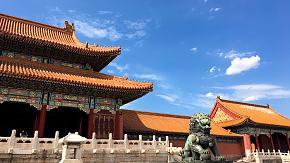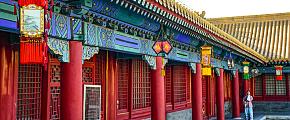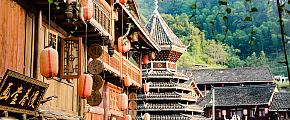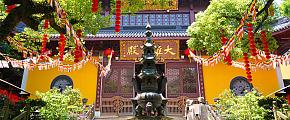Tangyue Memorial Archways and Tangyue Village
Tangyue Village is located near the southern foot of Huangshan Mountain and is famous for its memorial archways (gates). More than 250 arches were constructed here during the Ming (1368-1644) and Qing (1644-1911) dynasties. Over 80 of these magnificent arches are still in good condition.
The most notable are the Xuguo Stone Arch, and the set of seven Tangyue Memorial Arches, which were listed as a Key National Culture Protection Unit by the Chinese government. What makes the arches of Tangyue Village so unusual besides the sheer number is that each and every one had to be personally approved by the emperor before they could be erected.
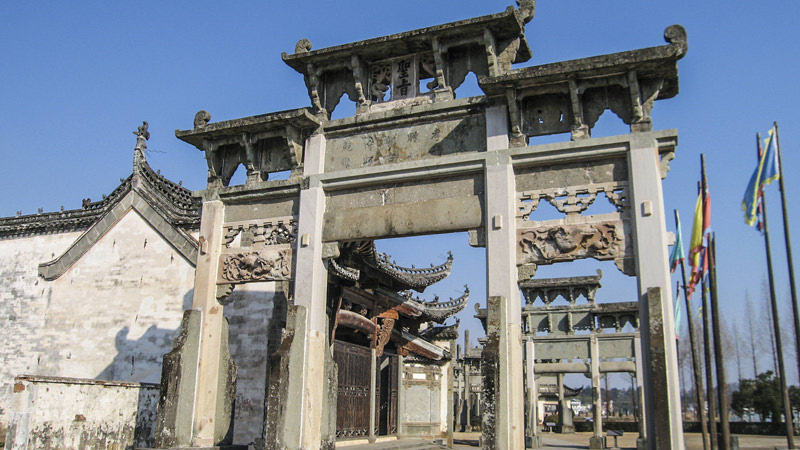 Tangyue Memorial Archways
Tangyue Memorial Archways
The stone archway is a unique architectural form in China. They were built from many different materials including wood, stone, and glazed tile. Each arch is built without the use of fasteners. They were ingeniously built using a mortise and tendon system and were held together for centuries simply by their massive weight. They were usually erected at the entrance to a town or a street.
They were designed as the embodiment of moral standards. They were built to honor individuals who made great contributions to the dynasty or were considered role models. The design and construction of each arch had to follow a rigid hierarchy. The number of pillars that supported the arch, the words, and the designs carved into them were closely associated with the status of the person honored.
Xuguo Stone Arch
The Xuguo Stone Arch stands out amongst all the arches built in Tangyue Village. Built during the Ming Dynasty, this arch honors Xuguo, who was a scholar and teacher of three heirs to the imperial throne.
What makes this particular arch so different is that according to legend, Xuguo took advantage of the vague instructions given by the emperor concerning his arch, and constructed it with eight posts. Eight post archways were only allowed to be built by members of the royal family in feudal China. It is the only eight-post memorial arch ever built by a person who was not a member of the imperial family in Chinese history.
Tanyue Memorial Arches
The Tanyue Memorial Arches is a set of seven arches built by the Bao family of Shexian Town during the Ming and Qing Dynasties. They are built along a curving road leading to Shexian Town. The seven arches represent the moral yardstick set by the family for their descendants to live by loyalty, filial piety, moral integrity, and righteousness. The Tanyue Memorial Arches are the biggest existing and best-preserved complex of arches in Anhui Province.
Three of the seven arches were built during the Ming Dynasty, and the remaining Four were built during the Qing Dynasty. The oldest arch was built during the reign of the Yongle Emperor (Reign 1402-1424). These arches have been used in numerous Chinese movies including the most recent Jet Li film "The Warlords".
There is a legend behind every arch. The most complete are the legends of the Ci Xiaoli Arch (Filial Piety Arch), and the Jie Jin San Dong Arch (Chastity Arch).
The Ci Xiaoli Arch was built to honor Bao Sheyan and Bao Shousun who were father and son. The father and son were captured by a general who wanted to execute one of them. Bao Shousun offered to be executed to save his father's life. Bao Sheyan being a loving father told the general that he had lived a long life and should be executed to let his son live.
This display of love and devotion so moved the general that he decided not to execute either one of them. When the emperor heard this story, he ordered the construction of this arch in commemoration of filial piety and self-sacrifice.
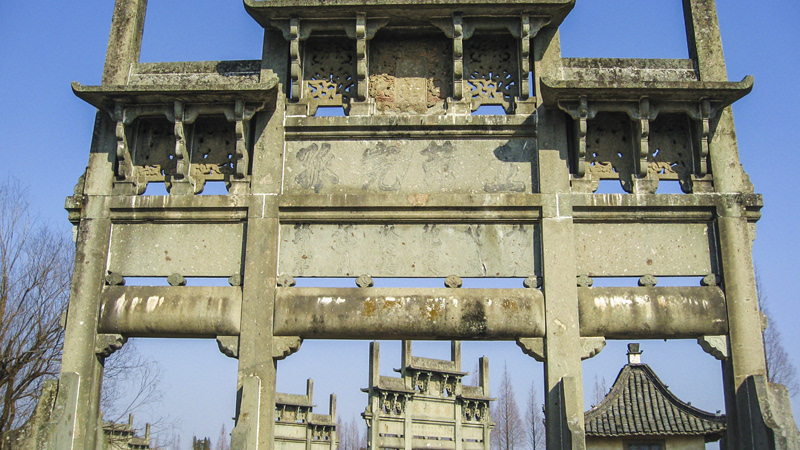 Tangyue Memorial Archways
Tangyue Memorial Archways
The Jie Jin San Dong Arch was built to honor a woman who remained chaste while raising her stepson after her husband had died. The woman's husband was Bao Wen who passed away when the woman was only twenty-nine years old. After her husband's death, the woman remained chaste and raised her stepson as her own. His righteousness inspired local officials to erect the Jie Jin San Dong Arch (Chastity Arch) in honor of her even though tradition dictated that no arch could be constructed for a second wife. This arch has stood as an inspiration to women for centuries.
Near the Tangyue Memorial Arches are two temples: the Qingyi Ancestral Temple and the Dunben Ancestral Temple. The Qingyi Ancestral Temple serves as an ancestral temple for women. Built during the Qing Dynasty, when women were not held in high esteem and had no power. During this time women were not allowed to enter ancestral temples, making this the first woman's ancestral hall ever built in China.
The Dunben Ancestral temple, often called "the male ancestral temple" was originally built in the Ming Dynasty. The hall houses Qing Dynasty business records of the "Hui Shang", businessmen from Anhui province. These ancestral temples were used by the Bao family to honor their ancestors and as a meeting place for the Bao clan. These temples were an important part of the Bao family's life. Funeral services, as well as wedding ceremonies, were held in them.
For a visit to the ancient Chengkan Village, simply contact us to tailor-make your China tour.
Related Posts You May Like
What Our Clients Say
"Great Customized Service", "Trip of A Lifetime", "Exceed All Expectations"

